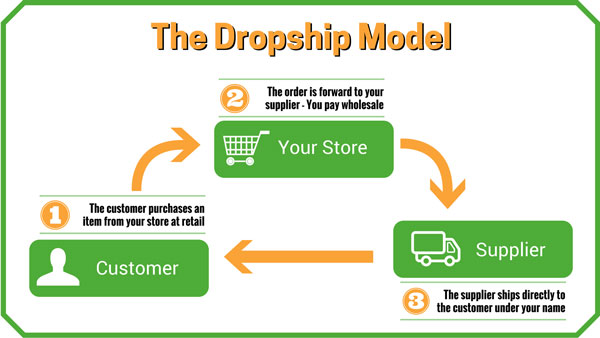Dropshipping 101
The Beginner’s Guide to Dropshipping
Becoming an entrepreneur always involves risk, work, and cost. But the good news for anyone considering entrepreneurship today is that the internet makes it possible to pursue a number of paths to entrepreneurship that involve less risk and cost than used to be possible.
One of those paths is to start a business that uses dropshipping.
What is Dropshipping?
Businesses that use dropshipping depend on another company to store and ship all the products they sell. Instead of maintaining inventory in a storeroom or storage facility, they trust another business to take care of all the physical aspects of running a retail business and focus on the rest.

The Benefits of Dropshipping for Your Business
Dropshipping appeals to a lot of new entrepreneurs because it takes some of the more costly and complicated parts of running a business of your plate.
1. Much Lower Startup Costs
You don’t need to worry about renting a storefront or storage space, a cost that’s often a considerable chunk of a new company’s budget. And you don’t have to pay for inventory in advance – another huge expense in starting a retail business – you can purchase it as it sells. On top of that, you don’t have to pay the cost of having items shipped to you, since they’ll be sent out directly to your customers. That’s several levels of savings that can make a huge difference in how much you spend to get your business off the ground.
2. Less Work
Not having to deal with physical items doesn’t just save money; it saves on time and labor. You don’t have to worry about receiving shipments and unpacking and organizing the items inside. You’re also off the hook for preparing boxes for shipment or tracking inventory.
The Challenges of Dropshipping
While starting a business that uses dropshipping has its benefits, starting any type of business will inevitably have its difficulties as well.
1. Logistics Can Get Complicated
A lot of companies that use dropshipping work with multiple suppliers. That means it can get tricky to keep up with who has what in stock and which orders have been shipped. In addition, anytime a customer orders multiple products that are sourced from different shippers, you have to figure out how to manage the different shipping costs in a way that doesn’t cause a disappointing experience for your customer (hint: charging them for multiple shipments separately likely won’t go over well).
While the process saves you a lot of trouble when it comes to things like tracking inventory and dealing with shipping yourself, drop shipping creates a different set of tasks and responsibilities you have to plan on dealing with.
2. Dropshipping is Competitive
Because of the low overhead costs and easier start-up process, a lot of people build businesses based on dropshipping inventory. Some of those people are willing to price low in order to sell more, which makes it hard for anyone else selling similar products to make the kind of profit that makes the business worth it.
This is possible to overcome. If you find a niche or some kind of unique positioning that sets you apart from the businesses competing on price, you may be able to reach the kind of customers who would rather go with a brand they relate to than find the cheapest seller. It definitely takes some work and strategic thinking though, and anyone that decides to run a business that uses dropshipping should expect to tackle that challenge.
3. It’s Still Running a Business
Handing over a few of the tasks of running a business doesn’t free you from the many other types of work involved. You’ll still need a business plan and strategy. You’ll still need to build a website, do marketing, and offer customer service. You’ll need to do accounting and will probably need to find and hire employees and contractors. If it were easy, everyone would be an entrepreneur. Using dropshipping is easier than some other types of running a business, but any entrepreneur that chooses to pursue this business model should still expect to do a lot of work.
How to Find Dropshippers
Finding the dropshippers you’ll be working with is one of the most important steps in any business that uses dropshipping, and it can be tricky for a couple of reasons:
1. Many legitimate dropshipping companies don’t do much online marketing.
Their websites are barebones and outdated, and they don’t bother investing in tactics like SEO. That means you’ll have to do some research and digging to find them.
2. Some of the websites that are easiest to find aren’t from actual dropshipping companies.
Instead, they’re scammers or companies that claim to do drop shipping, while really selling products at consumer prices. If you don’t know better, it’s easy to get sucked in by these businesses because they’re the easiest to find, but they’re not the businesses to work with if you want to build a profitable business using dropshipping.
Fortunately, there are a few steps you can take to find legitimate suppliers.
1. Research the manufacturers of your products.
Start by looking into the companies that make the types of products you’ll be selling. Do some digging to find a contact number and give them a call to ask if they provide dropshipping. If they do, they’ll usually be your most affordable option.
If they don’t, ask what distributors they work with. The list they provide gives you the next set of names to look into and get in touch with.
2. Browse an industry trade magazine.
While dropshippers usually don’t bother much with online marketing, some do actively advertise in industry-specific trade publications. Flip through any relevant industry magazines you can get your hands on and make note of any ads that appear to be from companies that sell the kind of products you’re looking for.
3. Attend a trade show.
If you can afford it, an industry trade show will be one of the fastest and most effective ways to make contact with the suppliers in your industry. Research the relevant tradeshows in your area and determine which make the most sense to attend. When there, spend time in the exhibits area talking to various suppliers and making contacts you can follow up with once you get home.
4. Go deep into Google.
If the first three steps produced a decent sized list of suppliers for you to consider, then you may not need to bother with Google. But if you still feel you need more options, then be willing to really spend some time and go further into the Google search results than you usually do.
SEO consultants sometimes joke that the best place to bury a body is on page 2 of Google, but you should be prepared to venture that far into the results to find legitimate dropshipping suppliers. One trick to help you find a relevant supplier more quickly is to limit your searches by location. A dropshipping company that’s located close to where most of your customers are likely to be will end up costing you less in shipping costs, so it pays to get specific.
5. Make sure they’re legit.
Any company that charges ongoing fees will cut into your profits needlessly. Legitimate dropshipping suppliers may charge an upfront set-up fee and/or a per-order fee, but they won’t ask you to pay recurring fees that aren’t tied to specific orders.
Consider placing a couple of test orders with a company early on so you can see the quality of the items yourself. These are the products that will be associated with your business and the brand you work on establishing; you want them to be up to your standards.
Ask about the technology a supplier uses. A company that runs efficiently will make your life easier, so look for a supplier that’s willing and able to communicate and process orders online.
Don’t be surprised if a dropshipping supplier won’t provide much detail on pricing or how they do business before you’ve set up your company as a legal entity. Their business model is based on selling to other businesses rather than directly to consumers, so you’ll need to demonstrate that you represent a legitimate business before they’ll be prepared to work with you.
How to Build Your Dropshipping Business
Like any other type of online business you start, you’ll need to go through a few main steps in order to establish your dropshipping business.
1. Choose your industry.
This is an important step to take before you start looking for dropshippers to work with. The industry you choose to work in will define the types of products you seek out, the audience you need to reach, and the branding you develop. Keep in mind that for a dropshipping business to be profitable, it helps to find a niche that’s largely underserved. Instead of selecting a broad industry, try to find a subset of that larger industry that doesn’t have too many sellers in it yet.
2. Research your audience.
Every business is dependent on its customers, so do all the research you can to understand who you’ll be selling to. Develop personas based on your research to help guide your branding and marketing. This should also help you pick the best products for your company, since you’ll gain an understanding of the types of products that most appeal to the people you want to reach.
3. Define your branding and positioning.
Now you have to develop your brand. Figure out what to call yourself and how you’ll position yourself in the industry. You want to figure out a way to set your brand apart from others selling similar items. That’s the only way not to get stuck competing on price. At this stage, consider bringing in a marketing consultant to help you get started on the right foot.
4. Determine your pricing.
It’s not just you, pricing is difficult for every entrepreneur. You need to figure out prices that cover your expenses and make you enough profit to make running the business worthwhile, but that aren’t too high to detract customers from buying. Do some browsing to see what other businesses are charging for similar products so you know the range you have to work within. Don’t try to be the cheapest option, but also don’t try to be the most expensive when you’re just starting out. Figure out a number somewhere in the middle that will work for you.
5. Build your website.
The most important single tool that every online business has is your website. Find a reliable hosting provider that offers fast speeds and put together a site that looks good and is intuitive for your visitors. You can use website builders that make it easier to build a website on your own, or invest in a graphic designer to give it more of a professional touch. Your website will be the main face of your business, so make sure you build one worthy of the brand you want to project.

6. Create your marketing plan.
Getting the website out there is the first big move to launching your online business, but your next big challenge is to get people to your site. That requires marketing. Consider hiring a marketing agency or consultant to help you create a plan that will get your website in front of people in your target audience. Do some research into tactics like SEO, PPC, content marketing, and email marketing. Your positioning is important to helping set you apart, but your marketing is what will really launch you ahead of competitors – but only if you do it well.
7. Develop your customer service plan.
The first sale is always the hardest to make. The businesses that succeed in the long term are the ones that are able to get customers to come back. Make sure you have a customer service plan in place to ensure that every person who buys something from your business has a stellar enough experience to want to do so again. Offer discounts and incentives to repeat customers to encourage loyalty. Decide early on what guidelines and tactics you’ll use to nurture the relationships you have with your customers and keep them coming back.
Yes, dropshipping is competitive. But good positioning, marketing, and customer service are the three most important tactics any business can use to rise above competitors. If you’re providing an experience that’s superior, you can get away with charging more without driving customers away. By making smart business decisions early on, you can enjoy the savings of dropshipping without falling into the trap of competing on price.
Via Hostgator








